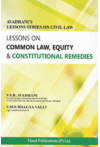- Author(s): V.S.R. Avadhani, V. Soubhagya Valli
- Publisher: Vinod Publications (P) Ltd.
- Edition: Ed 2021
- ISBN 13 9788193250884
- Approx. Pages 782 + Contents
- Format Hardbound
- Approx. Product Size 24 x 16 cms
- Delivery Time 3-5 working days (within Kerala & South India) (Others 7-9 days)
- Shipping Charge Extra (see Shopping Cart)
............................................................................................
Description
For any student of law, legal history and evolution of Codified law is an inevitable subject. In any legal system, during the early stages, the customs and traditions were the foundation of the modern legal system. Common Law and Equity are two facets of these precedents and practices that form basis for the modern legislations in any country. Common law has its origin in the English monarchy legal tradition, while the civil law has its background in the Roman law tradition. Common law systems are considered adversarial, and the judge moderates the process between parties, Civil law systems are considered investigatory, and the judge has the principal role in proceedings, as they establish facts, bring charges, examine the witnesses, and applyremedies, Common law is a body of unwritten laws based on courts' practice and experience; a sort of backup solution when the written statutory law has no forthright answer. Common law's purpose is to offer a solution when statutory law doesn't - or when relevant statutory law does not exist. It embraces the history and exhaustive records of decisions made by judges in unusual cases when there was no clear legislation to apply.The main principle that sustains the common law is, once a question receives an answer before a court, the same response should bedelivered for similar cases in future, known as precedents. Common law is practiced in various countries of the world and sometimes is taken into consideration when new legislation is declared.
............................................................................................
Table of Contents
Chapter 1 : Introduction
1. What is equity, equitable reliefs, and Remedies
2. Other equitable doctrines
3. Doctrine of Constructive trust
4. Unjust enrichment
5. Quasi Contracts
6. Equitable easement
7. Equitable defences
8. Equitable estoppel
9. Equitable Lieu
10. Equitable set-off
11. Other doctrines of equity
12. Equity of Redemption
13. Equitable title & Legal title
14. Equity & Law in ancient India
15. Common Law
16. Maxims of equity
17. Nature of Equitable interests
18. Judicial discretion & equity
19. Inherent Jurisdiction
20. Inherent Power of Court and Descretion
21. Discretion in Criminal trial Procedure
22. Writs
23.Equity & Laws in India
24. Doctrine of Public Trust
25. Principles of natural justice
26. Fair trial
27. Due Process of law
28. Rule of Law
29. Eminent domain
30. Inherent Powers
Chapter 2 : Judicial Review
31. Introduction to Judicial Review
32. Review of Judicial Decisions vs. Administrative decision
Chapter 3 : Doctrine of Legitimate Expecation
33. Legitimate expectation-introduction
34. Type of Legitimate Expection
35. Position of Ligitimate Expection in India
36. Legitimate Expectation-Important Indian Cases
Chapter 4 : Public Law Remedies
37. What is Public Law-Introduction
38. Constitutional Tort
39. Public Law Remedies-Writ Jurisprudence
40. Introduction to writs in India
41. 'State' import of Art. 12 of Constitution
42. Art. 136-Special Leave Power of Supreme Court
43. Writ of Habeas Corpus
44. Writ of Prohibition
45. Writ of Quo Warranto
46. Writ of Certiorari
47. Writ of Mandamus
48. Public Interest Litigation
Appendix
............................................................................................
Author Details
V.S.R. Avadhani, Formerty Secretary General Supreme Court of India, Former Judicial Member,
National Company Law Tribunal, Allahabad
V. Soubhgya Valli, Legal Consultant & Advocate
Foreword by
Hon'ble Justice A. Rajashekar Reddy, Judge, High Court for the State of Telangana

